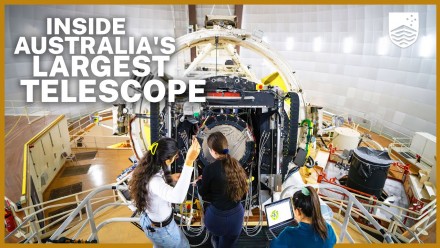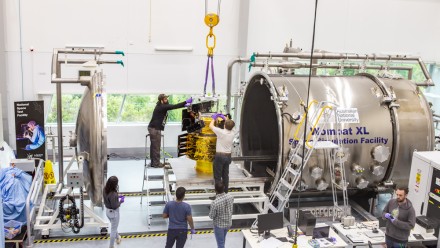Potential projects
Our research covers a broad spectrum of astronomy & astrophysics topics. Find potential topics for your research degree.
| Projects | Research themes | Supervisor | Degree |
|---|---|---|---|
| 3D printed optical translation stage | Instrumentation | Bachelor, Honours and Summer scholar course | |
| 3D printed water-cooled deformable mirror for high power lasers. | Instrumentation | Bachelor, Honours, Masters, PhD and Summer scholar course | |
| A Deep-Space and Lunar Optical Communication System: Optical ground station to support Artemis II | Instrumentation | Bachelor, Honours, Masters, PhD and Summer scholar course | |
| A high-altitude survey for nearby supernova | Instrumentation, Stellar and planetary astronomy, Structure and evolution of the Cosmos | Bachelor, Honours, Masters, PhD and Summer scholar course | |
| A resolved star formation study of galaxies using TYPHOON | Structure and evolution of the Cosmos | Honours and Summer scholar course | |
| Adaptive Optics for Laser Communication: iLaunch Trailblazer | Instrumentation | Bachelor, Honours, Masters, PhD and Summer scholar course | |
| Adaptive vibration cancellation in adaptive optics | Instrumentation | Bachelor, Honours, Masters and Summer scholar course | |
| AITC Adaptive Optics Test Bench | Instrumentation | Bachelor, Honours, Masters and Summer scholar course | |
| Are magnetic fields the scaffolds of galaxies? | Galactic archaeology, Structure and evolution of the Cosmos | Bachelor, Honours, Masters and PhD | |
| Asteroids studies with the Kepler Space Telescope for Future Asteroid Mining | Stellar and planetary astronomy | Bachelor, Honours, Masters, PhD and Summer scholar course | |
| Bulk motions in the nearby Universe and the approach to homogeneity | Structure and evolution of the Cosmos | PhD | |
| Closing the gap: Tracers of the interstellar medium in GALAH spectra | Galactic archaeology | Bachelor and Summer scholar course | |
| Computational astrophysics studies in turbulence, magnetic fields, and star/galaxy formation and evolution | Stellar and planetary astronomy, Structure and evolution of the Cosmos | Bachelor, Honours, Masters and PhD | |
| Connecting the Galactic and Extragalactic with MUSE: a comparison of integrated and resolved stellar populations | Galactic archaeology, Structure and evolution of the Cosmos | Honours, Masters and PhD | |
| Constraining cosmic ray dynamics with gamma-ray data | Stellar and planetary astronomy, Structure and evolution of the Cosmos | PhD | |
| Cosmic Magnetism and the Universe’s Biggest ‘Dye Tracer’ Experiments: Deciphering The Impact and Lifecycles of Outflows from Supermassive Black Holes. | Black hole phenomena, Structure and evolution of the Cosmos | Bachelor, Honours, Masters, PhD and Summer scholar course | |
| Dancing with the Stars: Rotation periods and rotational velocities for the open clusters Messier 67 and Ruprecht 147 | Galactic archaeology, Stellar and planetary astronomy | Bachelor and Summer scholar course | |
| Design and simulation of an Ultraviolet spatial heterodyne spectrometer instrument | Instrumentation | Bachelor, Honours, Masters and Summer scholar course | |
| Do star clusters have a mid-life crisis? The age gap between open and globular clusters in the Milky Way | Galactic archaeology, Stellar and planetary astronomy | Bachelor and Summer scholar course | |
| Dockerising optical sensors and correctors | Instrumentation | Bachelor, Honours and Summer scholar course | |
| Double stars observations at Mount Stromlo Observatory for satellite laser communications | Instrumentation | Bachelor, Honours, Masters, PhD and Summer scholar course | |
| Exploring Galactic magnetism through radio polarization | Galactic archaeology, Structure and evolution of the Cosmos | Bachelor, Honours, Masters and Summer scholar course | |
| Exploring the Ultraviolet Extinction Landscape: A Mission Concept for Probing Interstellar Medium Composition in the Milky Way and Local Group Galaxies | Instrumentation, Structure and evolution of the Cosmos | Bachelor, Honours, Masters and Summer scholar course | |
| Extended Main-sequence Turn-off in Galactic Open Clusters | Galactic archaeology, Stellar and planetary astronomy | Bachelor, Honours and Masters | |
| Formation History of the Milky Way from Stellar Observables | Galactic archaeology, Structure and evolution of the Cosmos | PhD | |
| Gas motions and excitation in edge-on barred galaxies | Galactic archaeology | PhD | |
| Ground Layer Adaptive Optics system for the 8-metre Subaru Telescope in Hawaii | Instrumentation | Bachelor, Honours, Masters, PhD and Summer scholar course | |
| HI Absorption-Emission Fitting: A New Approach | Structure and evolution of the Cosmos | Honours and Masters | |
| Infrared sensor systems for Astronomy and Earth Observation from space | Instrumentation | Honours, Masters and PhD | |
| Investigating Spatial Light Modulators and Pyramid Wavefront Sensing | Instrumentation | Bachelor, Honours, Masters and Summer scholar course | |
| Just another brick in the halo | Galactic archaeology, Stellar and planetary astronomy | Bachelor, Honours and Masters | |
| Laser Communications Site Testing and Analysis | Instrumentation | Bachelor, Honours, Masters, PhD and Summer scholar course | |
| Laser Guide Star Adaptive Optics for deep space optical communications: The Moon and beyond. | Instrumentation | Bachelor, Honours, Masters, PhD and Summer scholar course | |
| LLMs for systems engineering | Instrumentation | Bachelor, Honours and Summer scholar course | |
| Magellanic foreground: The handshake between HI gas and Galactic magnetic field | Structure and evolution of the Cosmos | Honours and Masters | |
| Mapping azimuthal variations in metals across cosmic time | Structure and evolution of the Cosmos | PhD | |
| Measuring the masses of black holes in distant galaxies | Black hole phenomena, Instrumentation, Structure and evolution of the Cosmos | Bachelor, Honours, Masters, PhD and Summer scholar course | |
| Meta-surface lenslet arrays for adaptive optics | Instrumentation | Bachelor, Honours, Masters, PhD and Summer scholar course | |
| Multiple Stellar Populations from a Single Galaxy Spectrum | Galactic archaeology | Honours | |
| Opening the dynamic infrared sky with DREAMS | Instrumentation | Bachelor, Honours, Masters, PhD and Summer scholar course | |
| Precision astrometric reference source for optical calibration | Instrumentation | Bachelor, Honours and Summer scholar course | |
| Pulsars as a probe of the ionised gas in the Milky Way | Galactic archaeology, Structure and evolution of the Cosmos | Bachelor, Honours, Masters, PhD and Summer scholar course | |
| Reinforcement learning for phasing giant telescopes | Instrumentation | Bachelor, Honours, Masters and Summer scholar course | |
| Satellite galaxies as probe of structure formation in our cosmic backyard | Galactic archaeology, Structure and evolution of the Cosmos | Honours, Masters and PhD | |
| Shaping the Magellanic Stream with the Magellanic Corona: A Faraday Rotation search | Structure and evolution of the Cosmos | Bachelor, Honours, Masters and PhD | |
| Simulated observations of galactic wind metal loading | Stellar and planetary astronomy, Structure and evolution of the Cosmos | Honours and Masters | |
| Simulated Observations of the Magnetic Fields of the Milky Way | Galactic archaeology, Structure and evolution of the Cosmos | Bachelor, Honours and Summer scholar course | |
| Simulating integral field spectrograph images for MAVIS | Instrumentation | Bachelor, Honours and Summer scholar course | |
| Simulating the formation of the first galaxies | Structure and evolution of the Cosmos | Bachelor, Honours, Masters and PhD | |
| Synergy between future 21-cm experiments and physical cosmology | Structure and evolution of the Cosmos | Honours and PhD | |
| Taking the Temperature of a galaxy | Galactic archaeology, Structure and evolution of the Cosmos | Bachelor, Honours, Masters and PhD | |
| Taking the temperature of red giant stars in Globular clusters | Galactic archaeology, Stellar and planetary astronomy | PhD | |
| The chemistry of M dwarfs from colours | Galactic archaeology, Stellar and planetary astronomy | Masters and PhD | |
| The dinosaurs of the Milky Way: high precision chemical abundance measurements of ancient star clusters | Galactic archaeology, Stellar and planetary astronomy | Bachelor and Summer scholar course | |
| The Galactic ASKAP Survey of Atomic Gas structure and temperature of the Magellanic System | Galactic archaeology, Structure and evolution of the Cosmos | Bachelor, Honours and Masters | |
| The Oldest Stars in the Universe | Galactic archaeology, Stellar and planetary astronomy | PhD | |
| The origin of filamentary structures in the interstellar medium of spiral galaxies | Structure and evolution of the Cosmos | Bachelor, Honours, Masters, PhD and Summer scholar course | |
| The Origin of the High Galactic Latitudes Asymmetry in the Milky Way Magnetic Field Structure | Galactic archaeology, Structure and evolution of the Cosmos | Bachelor, Honours and Summer scholar course | |
| The origin of the mass step in supernovae | Structure and evolution of the Cosmos | Honours and Summer scholar course | |
| The Origins of Elements with Next-Generation Stellar Spectroscopy | Galactic archaeology, Structure and evolution of the Cosmos | PhD | |
| The Pyxis Space Interferometer Prototype | Instrumentation, Stellar and planetary astronomy | Bachelor, Honours, Masters, PhD and Summer scholar course | |
| The rise of supermassive black holes | Black hole phenomena, Structure and evolution of the Cosmos | Honours, Masters and PhD | |
| The ultraviolet excess of hot stars: there or not? | Galactic archaeology, Stellar and planetary astronomy | Bachelor, Honours and Masters | |
| Toward improved measurements of galactic wind mass fluxes | Stellar and planetary astronomy, Structure and evolution of the Cosmos | PhD | |
| Understanding the gamma-ray emission from the Galactic Centre’s giant outflow | Galactic archaeology | Honours, Masters and PhD | |
| Uniting optical and infrared spectroscopy with GALAH and APOGEE | Galactic archaeology, Stellar and planetary astronomy | Bachelor, Honours, Masters and Summer scholar course | |
| Unveiling the Mysteries of the Magellanic Stream: Galactic ASKAP HI Absorption Study | Structure and evolution of the Cosmos | Honours and Masters | |
| Weighing gravity with galaxy motions | Structure and evolution of the Cosmos | PhD | |
| What new information can we extract from stellar spectra? | Galactic archaeology, Stellar and planetary astronomy | Bachelor, Honours, Masters and Summer scholar course | |
| Where does Galactic antimatter come from? | Black hole phenomena, Galactic archaeology, Structure and evolution of the Cosmos | Honours, Masters and PhD | |
| Why does the inner Galaxy glow in gamma-rays and radio emission?: dark matter, ancient pulsars, neither or both? | Black hole phenomena, Galactic archaeology, Structure and evolution of the Cosmos | Honours, Masters and PhD |











